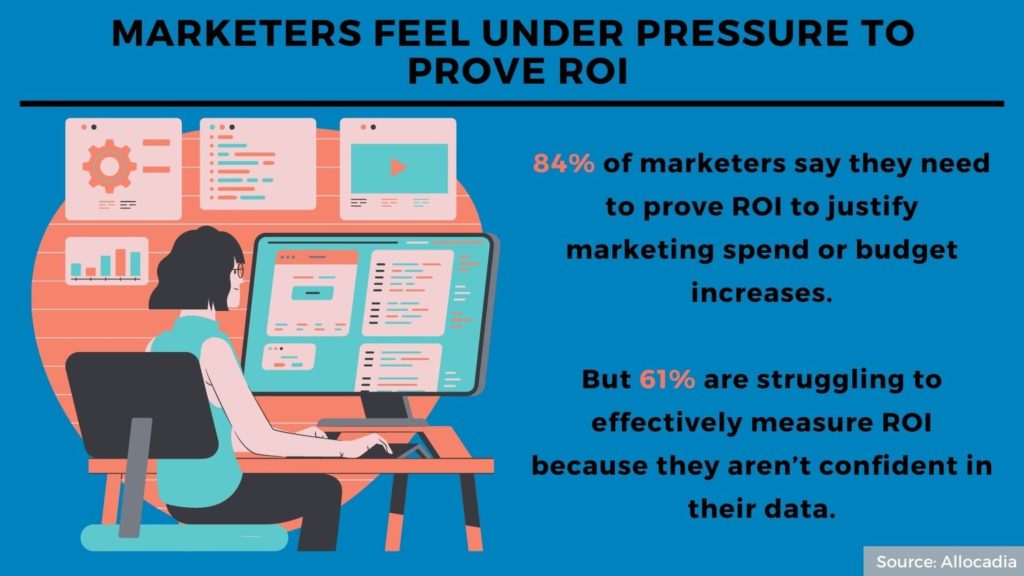Download the PDF
Being a marketing leader seems easy enough, right? Set goals, steer and manage your team to reach them, and report back the results.
In practice it isn’t that simple. And marketing leaders can often get stuck in a rut of what they think leadership should look like, or copying how things have always been done, instead of pioneering new strategies to succeed.
Maybe you’re reading this because you’re no longer reaching your goals, or you’re bored of how you’ve been operating and are looking for inspiration.
When looking to change, the main question you have to ask yourself is: ‘What is really holding me back from achieving greater success?’
We have worked with thousands of marketing leaders and found common reasons for why they aren’t reaching their potential and how a slight shift in approach can help them reach new heights. In this guide we’ll explain what we’ve found and explain what you can start doing today to become an impactful marketing leader.
First off, why is great marketing leadership so important?
Marketing is at the core of every business, and marketing leaders need to be too. They need to be the thread that brings together all areas of the organization, ask smart questions and see the bigger picture.
As the spearhead of the marketing team, leadership can make or break a company. Here are the most common reasons we’ve found:
1. Steer company strategy
Marketing is at the forefront of the business and it’s important for leaders to keep on top of new trends and changes in society that might mean a shift in overall business strategy. The marketing team knows the customer in a way that no other department does and as a result, leaders constantly need to report back and let this information steer the whole company’s strategy.
2. Manage the brand image and story
Marketing often shapes the company vision and story, externally to customers in the branding, storytelling and strategies, and also in internal communication. The brand image internally and externally is one of the most important aspects of a business.
It’s for this reason that marketing leaders understand the whole customer journey from awareness to sales to account management and retention.
3. Lead digital transformation
Digitalization is a huge part of the marketing team and in the current industry climate, it has to be. Marketing is constantly evolving and marketing teams need to evolve with it in order to keep up.
It is the job of marketing leaders to learn what technology is needed and when. There are so many channels and processes for marketing teams now that identifying the right technology is key to not only the marketing team but Sales, Customer Success and so on.
What does it take to be a successful marketing leader?
We’ve highlighted the importance of great marketers, but not everyone who reaches this position is necessarily equipped to succeed. While industry needs differ, we’ve found commonalities in the traits of highly impactful marketing leaders.
1. They’re excellent storytellers
Marketing is all about connecting with people, even if you work for a B2B company, we are all selling to people. To be a successful marketing leader you need to create a solid story that people can resonate with, and help your team spread that message across all activities.
Take this example, while many marketing teams think they’re telling a story, they’re really just presenting data nicely.

2. They’re inquisitive and innovative
Like we said before, marketers who constantly do things the same way will not succeed for long in this industry. As a leader you should question things, test out new approaches and aim to keep learning.
Those who think they have all the answers, are only hindering themselves and their team’s performance. To read more on this, check out our blog How CMOs should rethink innovation to improve marketing results.
3. They’re open-minded
Albert Einstein famously said: “The definition of insanity is doing the same thing over and over again, but expecting different results.”
Same goes for marketing leaders. In order to make an impact, generate results, and inspire your team to strive for better, you need to be open to new ideas, technologies and suggestions from your colleagues, regardless of what level of ‘experience’ someone has.
Congrats, you have already taken the first step by reading this guide!
Open-minded leaders retain the best talent as teammates feel heard and respected. We go more into this topic in our blog here. (link to open-minded blog once live)
Being open-minded also means taking risks. We’re not talking blowing the whole budget in the blink of an eye because you had a hunch, but trying new techniques, testing and iterating and testing again. To take risks, reliable data is hugely important.
4. They’re data-driven
As nice as it all sounds–pushing boundaries, being a revolutionary–we know that it can be easier said than done. There are often barriers in place such as budget cuts and red tape from senior management. This is where data is so important.
Data doesn’t lie. Not reliable, clean data like you get in Mediatool anway (shameless plug). To get the bigger picture and see where you can take risks and try new ideas, you need a full view of all your marketing data. In order to test and increase performance, you need data to back up your claims. This data can then help you with those barriers, by showing senior management why you need to make space in the budget or how the business will fare better in the long run.
Research has shown that “digital advertising remains the largest driver of revenue, with income reaching £53.6m in the first three months of 2021, a 4.7% increase versus last year.” Yet in the meantime, “84% of marketers say they need to provide ROI to justify marketing spend or budget increases… but many are struggling to effectively measure ROI because they aren’t confident in their own data.” So, marketers need to be data-driven but also have confidence in that data.

(Allocadia via Marketing Week)
Mediatool gives marketing leaders a full overview of all marketing activity and corresponding data. Next to this you can see your future plans, targets and budget. If you need to prove ROI to the wider business, simply generate a custom report in seconds. It’s done so quickly that you have more time to focus on your new mindset and approach to marketing.
5. They think long-term
Marketing is a fast-paced industry with constant changes and trends emerging left, right and centre. While it’s important to adapt and keep up, it’s also important that marketing leaders are not short-sighted when making decisions.
Those who succeed are those who constantly have the long-term goal in sight. Rather than getting stressed at a drop in engagement, they consider if it will impact the wider strategy and team wellbeing.
Think of a long-term outlook like sustainable brand building, rather than driving short term sales. This separates the companies that are always top of their game from those that pop onto the scene and disappear in a matter of years or months.
The best example of a leader who thinks about the long-term strategy is Amazon’s CEO, Jeff Bezos. Bezos is quoted as always thinking 3 years ahead and he claims this is the reason for his success. In a 1997 letter to Amazon shareholders, Bezos created a manifesto which he called “It’s all about the long-term”. In this he explained his approach, which stated that all business decisions would be made with a long-term lens.
He is more recently quoted saying “I don’t think that you can invent on behalf of customers unless you’re willing to think long-term, because a lot of invention doesn’t work. If you’re going to invent, it means you’re going to experiment, and if you’re going to experiment, you’re going to fail, and if you’re going to fail, you have to think long term.”
Although the leader of a company and not the marketing team, this mindset is pivotal to great marketing teams too.
How to shift your mindset to become an inspirational leader
We’re aware that you can’t control every aspect of your job or circumstance. But you can take charge of your approach to it. And the key to creating impact as a leader, is adapting your outlook to obstacles.
Here we’re going to dive into the challenges that marketing leaders face and how you can personally rethink your thought processes and actions to achieve your goals.
1. Create your own motivation
You want to build a marketing machine that constantly delivers and hits KPIs, whilst keeping your team happy and motivated. But you don’t ‘have the time’ to switch up the strategy or the nerve to strive for more.
The bottom line is that you kind of want to reach new heights, but you’re also comfortable where you are and how things are ticking on. This goes for all areas of your life. If you want to get fit but you’re comfortable not exercising, you most likely won’t. And in both instances you’ll wonder why change hasn’t happened yet.
Ultimately in your mind there are no consequences to staying the same. And staying in the comfort-zone has likely been a habit of yours for a while now.
What you can do:
- Create your own negative consequences for if you don’t reach your goals. A great example of this is holding yourself accountable by announcing to the team that your goal is X, and this you are going to achieve it by doing X, Y, Z. To make it feel more real, put it into a presentation where people will ask you about your progress.
- Allocate budget to your goal. For example, you want to surpass your KPIs but you and your team are at max capacity and your main excuse is ‘I don’t have enough time’. By investing in something such as technology that can help you manage your marketing activities and streamline processes for you and your team, you will have more time to reach your goals. By spending budget on this technology, you push yourself out of your comfort zone as there is a financial consequence if you don’t.
2. Get better at decision-making
One of the main challenges for marketing leaders is burnout. Either for them, or their team, or both. And this was only exacerbated by the pandemic where teams were working with reduced resources, less hands on deck and the constant ability to be online while working remotely.

For leaders, a main cause of burnout is decision fatigue. It’s estimated that the average adult makes 35,000 decisions per day. How they measured it, we don’t know but one thing’s for sure, it’s a lot! From simple decisions like ‘what should I eat for breakfast?’ to more stressful ones like ‘Do we need a complete rebrand?’ Making effective decisions means getting focused to make them in the first place.
In order to get laser-focused and clear when making decisions, ask yourself these questions:
- Do I need to make this decision in the first place? Or can I delegate the responsibility to someone in my team?
A quick and easy way of getting better at making decisions is ensuring you’re the right person to be making them in the first place. Is someone else better-equipped? Can you give the responsibility to a team member who is more than capable? Would it help to open the floor to a team discussion?
While your instinct may be to take the burden on yourself, you’re more likely to end up making the wrong choice and regretting it. Instead, delegate some of the decision making to other specialists in your team or organization. That way you also remove unnecessary pressure on yourself and can focus your attention where it’s needed.
- Have I looked at it from a wider perspective?
We mentioned previously the importance of long term thinking for marketing leaders. Instead of making a snap decision, take a step back, look at all the insights available to you and consider the best course of action for the overall strategy and team goals.
It can be easy to see a slump in performance and make a snap decision, but marketing leaders that are clever decision makers, look at the wider picture.
One of the biggest challenges in marketing decision making is data silos. We designed Mediatool to help give leaders a full picture of their marketing operations, with custom reporting dashboards tracking all your data in one place in real-time, making your next decision has never been easier.
- How can I reframe this decision as an opportunity?
Sometimes the weight of a decision can cause stress and anxiety and that stress can trickle down to the whole team.
Although it’s important to look at the whole picture and weigh up a decision, try to change your perspective and reframe it as an opportunity. By doing this, you instantly release the mental load that you’re carrying and will think about it more positively, making the choice easier.
3. Use data to help your decisions, not hinder them
All marketers have numerical goals, objectives and targets they want to achieve. A lot of the time, the issue lies in the action and often overreaction that happens at the slightest uptake or downturn in metrics. A big part of getting better at decision making is knowing what action to take and when. And this is where a lot of marketing leaders fall flat without even realizing it.
Using your data wisely will help you determine whether the result holds weight and will positively or negatively impact the whole campaign. This will tell you if you need to make a decision or if it’s just a standard fluctuation that you’ll forget as it averages out. Working this out doesn’t have to be complicated. Many marketing teams use metrics to focus on growth, but that is where they also sometimes miss a trick. Instead of focusing on growth, successful marketers use this data to learn.
Let’s be honest, you don’t have time to sit and analyze every fluctuation in metrics, and neither does your team. Reshaping how you view your data will help you make quicker and better-informed decisions.
Start with visualizing the potential trajectory of your results. Draw a chart and plot where the metrics were recently and where they are now. Draw a line between the plotted numbers, this is your average assumption of where the results will go. Now draw two more lines, using your highest and lowest data points from recent fluctuations, draw an upper and lower outer limit.
By drawing this simple chart, you can visualize if your metrics show a long-term trend or a short-term discrepancy, without even being a numbers person. As basic as it might sound, this approach helps you make a data-driven decision that is also well balanced.
4. Customer-first mindset
Marketing teams arguably have the most access to customer information in any business, and leaders that make an impact internally and externally not only shift their own mindset but can easily empathize with and understand existing and potential customers.
According to research by Epsilon, 80% of consumers are more likely to purchase when brands offer experiences personalized to them. This is universal across industries and product types. If you want to create meaningful and personalized experiences for your customers, you need to look at your marketing from the outside in, and remove your bias to truly understand how to answer the customers’ needs.
Before launching your next campaign or testing new ad creatives, create a rule where you and your team ask themselves “Does this help our customers?” If the answer is no, don’t bother running with it. This question will help you switch your perspective and will also encourage a customer-centric mindset within your whole team and company.
When becoming customer-centric, data is your best friend. Collating your customer data in one place is vital to ensuring you understand what does and doesn’t help them.
The reason many companies fail to meet customer needs is because of data silos internally. You know what we mean, Marketing has different data from Sales who have data in a different system to Customer Success. Look we’ve been there too, the great thing is that you can easily change that. By using one platform to consolidate all of your data (like Mediatool!) you can ensure you have the correct and up-to-date information to woo your customers away from your competitors and create a personalized experience.
5. Give responsibility and autonomy to your team
It can be daunting delegating your tasks to others but part of being a leader is leading, and empowering others to grow too. If you want world-class results, you need to create a world-class team and that means giving others more responsibility to thrive.
Marketing has a high employee turnover rate and if you want to keep your team happy, they need to feel a purpose, like they are adding value to the wider business and given credit where credit is due. By encouraging employees to take ownership, risks and innovate in their role, you will generate better results for the whole company.
6. Be savvy about martech investment
In this guide we’ve outlined a lot of things you need to do to become an impactful leader. Now, we understand that these things take time. Part of realizing what and when to delegate includes what technology can help you do your job too. If the pandemic has taught us anything it’s the need for technology to help us do our jobs, especially for marketers.
When done correctly, marketing software pays for itself by organizing and centralizing all marketing activities–briefs, plans, budgets, performance data–the list goes on. By now, you know you need to embrace this technology if you haven’t already. But most of you probably have. The question is: have you made the right choices? Does the technology actually make you and your team’s jobs easier? Or maybe it does, but it feels like a waste of money as no one is using it. Why aren’t you using it?
Investing in marketing technology isn’t just about ticking a box. You can’t just pay for it and all of a sudden watch your performance sky-rocket, your team become motivated and senior management love you. Investing refers to mentally investing too. Choosing a platform is actually fairly easy, there are many different types out there. The leaders who set themselves up for success accept that moving to a new software might take time, need all hands on deck and sometimes feel like effort. But those that do embrace it and are clever about how they use it to assist them in their role and they embark on the journey anyway, as they know the reward will be worth it in the long run. And this is how you need to think too if you’re going to be one of the best.
Whilst some teams don’t use the technology how they should, others put their eggs (data) in too many baskets (platforms). Contrary to what you might think, you don’t need a different solution for each area of marketing. That creates silos and unclean and unreliable data. Instead, find a platform that consolidates all of your marketing data in one place, customized to your team’s way of working and taxonomy.

7. Build on your team’s strengths
We’ve all experienced not-so-great managers, and dreaded performance reviews where they list your weaknesses and focus on areas of improvement, instead of your strengths. While it can be helpful, try to nurture and build on your team’s strengths instead.
Everyone has strengths and weaknesses, but by shaping your team to focus on the individual’s strong points, they will flourish in their role and the quality of work they produce will increase.
Think of your team like a Premiership football club. The coaches don’t waste time telling the goalie that he/she needs to improve their striking or dribbling skills, as that isn’t their area of strength. Instead they support the goalie to improve their hand-eye coordination, decision-making and agility. And they use this information to build the best teams in the world.
Author and accredited Business Consultant, Marcus Buckingham, tells managers to see strengths as opportunities: “Identify a person’s strengths. Define outcomes that play to those strengths. Find a way to count, rate or rank those outcomes. And then let that person run.”
Work with your team to identify their strengths, empower them to build on them, and then give them the tools to constantly become better than they were before.
Wrapping up
Heading up a marketing team has never been more exciting. Traditional marketing methods are dying out, creating massive opportunities for those who are willing to challenge the status quo. The role of a marketing leader is evolving from what it once was, as it becomes more important within the whole business and culture.
For leaders to survive and thrive in this new era of marketing, they need to start with their mindset. They need to push boundaries, reinvent processes and embrace technology that makes marketing more impactful for their teams and customers.
Interested in learning how Mediatool helps you become a better marketing leader? Book a demo to find out.





